How to Convert USB 2.0 to 3.0?
"I have a USB 3.0 flash drive that supports 4800 Mbps transfer speed. The problem is, my PC has only a USB 2.0 port. Is there a way to convert USB 2.0 to USB 3.0?"
Do you also wish to convert your USB 2.0 to 3.0? A USB 3.0 lightning-fast transfer speed makes it compulsory to have these days. However, don't worry if you do not have a USB 3.0 on your laptop or desktop.
Through this article, you will learn the difference between a USB 3.0 and 2.0 and how you can use adapters to convert USB 2.0 to 3.0.
Content Navigation
Part 1: Difference Between USB 3.0 and 2.0
Universal Serial Bus (USB) is a standard that provides an interface to connect your computer with any peripheral device. With a lot of advancements in technology, USB 3.0 has become the new standard for USB devices.
While comparing USB 2.0 and USB 3.0, they vary in size and a handful of other things that distinguish them. This section has gathered the significant differences between USB 3.0 and USB 2.0. Read below to understand the difference.
1. Physical Difference
You may wonder: if there are any physical differences between USB 2.0 and USB 3.0? How to distinguish both of these by their appearance? Well, that's not difficult. Many computers have both USB 2.0 and USB 3.0 ports.
a) Color Difference
The above image displays both USB 2.0 and USB 3.0 ports. The left port is USB 2.0 colored black from inside, while the port on the right is USB 3.0 colored blue from inside.
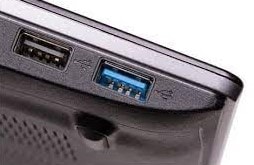
b) Number of Wire Connections
Another difference between USB 2.0 and USB 3.0 is the number of wires connected. USB 2.0 supports half-duplex communication and has a total of 4 connector wires. Whereas USB 3.0 has a capacity of 9 connector wires. It permits two-way communication simultaneously by having five additional wires due to an increase in its bandwidth.
2. Price
USB 2.0 version is generally less expensive than the USB 3.0 version. You can buy a suitable USB 2.0 device much cheaper. USB 3.0 is comparatively costly for sure since it offers ten times faster transfer speeds. It can even reach more high if you opt for your desired features.
That's up to your choice, but if you frequently transfer huge files, USB 3.0 still be a better choice for you if you can afford it.
3. Speed
Compared to USB 3.0, the data transfer rate of USB 2.0 is prolonged, which is at 480 megabits/s (60MB/s). While USB 3.0 is ten times faster than USB 2.0. Its data transfer rate is up to 4800 Mbps, i.e., 625 Mbs per second.
4. Compatibility
USB 3.0 ports are backward compatible. That is to say, and if you connect a USB 2.0 drive to a USB 3.0 port, the drive will work as expected. USB 3.0 will exhibit the transfer rate similar to USB 2.0 drive would while connecting to a USB 2.0 port.
USB 3.0 devices are also backward compatible means. If you plug a USB 3.0 flash drive into a USB 2.0 port on your PC, it still can be readable. However, the USB 3.0 will work at the speed of the port, no matter it is port 2.0 or 3.0. So, in this case, the superfast transfer rate of USB 3.0 is not fully realized.
5. Power Management
Compared to USB 2.0, USB 3.0 provides more efficient power management and increases power delivery.
USB 2.0 can deliver power up to 500 mA, whereas USB 3.0 caters up to 900 mA. It increases total power delivery from 2.5 W to 4.5 W (5 V). So as far as charging is concerned, USB 3.0 devices can be charged faster.
The USB 3.0 devices deliver power when required and conserve energy when the device is connected but idle. So USB 3.0 is more advanced than USB 2.0 in terms of power management.
Summarizing
Here the question arises, "Which One Should You Choose ?"
Well, now you understand the main differences between both versions. So you can easily opt for one fulfilling your needs reasonably. So far now, the only defect of USB 3.0 is that it is more expensive than USB 2.0.
In terms of USB 2.0 vs. 3.0 from various aspects, USB 3.0 offers the fastest speed, is backward compatible, and offers higher efficiency power management than the old USB 2.0.
Part 2: 5 Tips to Convert USB 2.0 to 3.0
For the question of "Which is better? USB 3.0 or USB 2.0?" the significant differences in speed, cost, power management, and compatibility show a clear edge of USB 3.0 over USB 2.0.
Now it's time to jump onto the main thing, how can you possibly convert USB 2.0 to 3.0? It is where we come for your help. Below is our compiled list of the best USB 2.0 to 3.0 adapters out there and how you can use them.
1. Anker 3-Port USB 3.0 Portable Data Hub with Ethernet Port
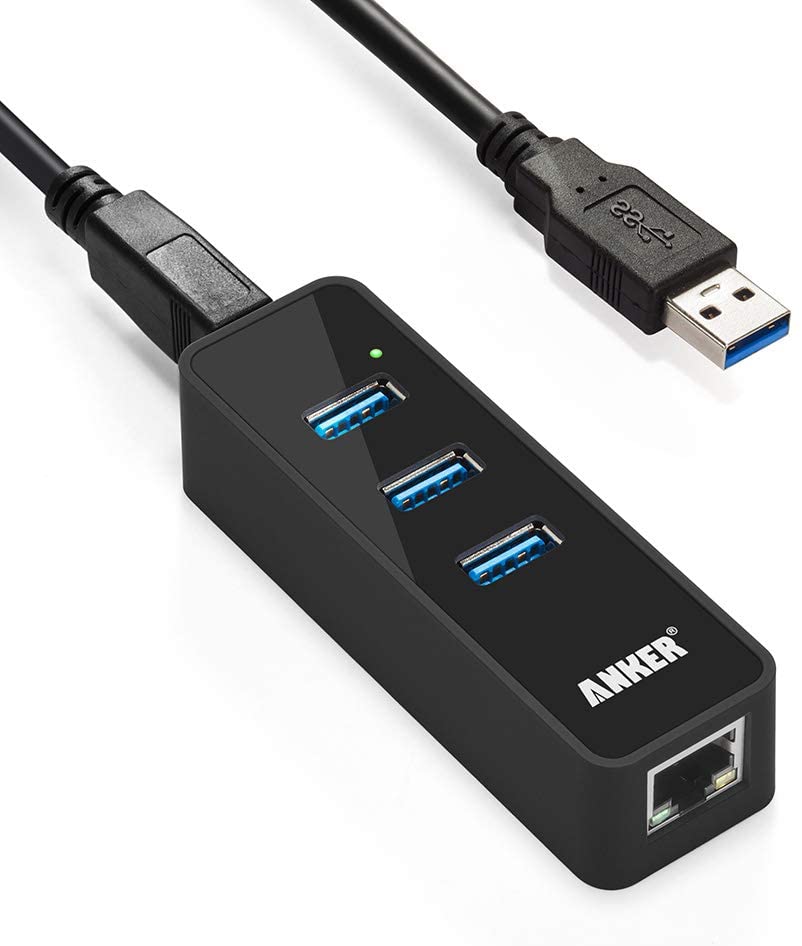
The price of this three-port Anker hub, along with an ethernet port available at Amazon, is $29.99.
This portable data hub from Anker, consisting of a lightweight power-bar design, ensures very little space that can easily fit into your pocket as well. It is measured as 0.91 by 1.18 by 3.7 inches (HWD). It consists of a glass-like top surface where the three USB 3.0 ports lie. Ethernet cable can be connected on its lower edge that provides access to superfast network speeds.
1-gigabit ethernet ports allow it to be backward compatible with 10/100 ethernet. Moreover, it enables you to enjoy the data transfer speed up to 5Gbps. Its built-in surge protection keeps your device and data safe as well as supports hot-swapping.
The cons of this Anker hub are that it is compatible only with windows, Mac OS X, but does not support Linux 2.6.14 below.
2. Anker 7-Port USB 3.0 Aluminum Portable Data Hub with Power Adapter
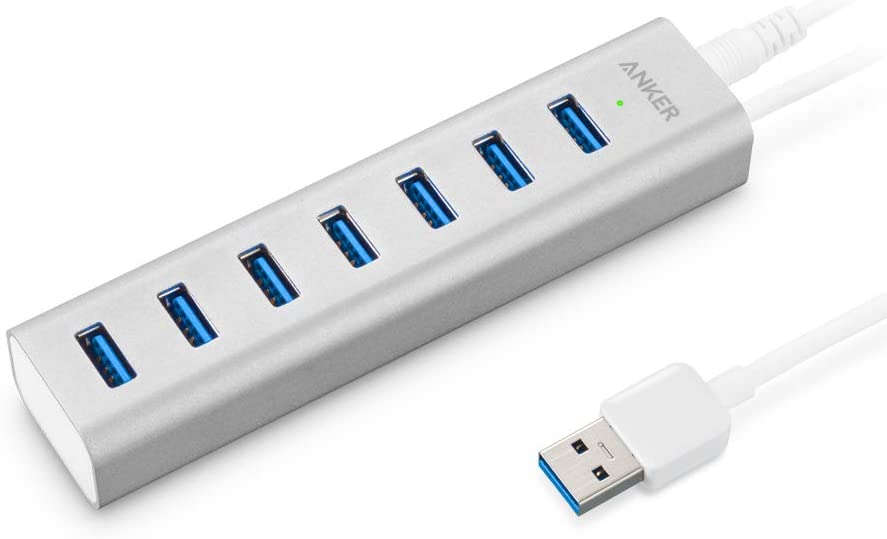
The price of this seven-port Anker hub, along with a power adapter available at Amazon, is $30.00.
It is a leveled-up version of the Anker 3-Port USB Hub that saves your time in synching. Hence, supporting the data transfer rate of up to 5 Gbps. It powers solely through a USB connection. To attain a higher power output, you can connect the hub to the five-foot power adapter cable. It will enable you to free your laptop from the draw on its battery.
Its built-in surge protection provides safety to your devices and data. And it supports hot-swapping. Moreover, there is no need of drivers for Windows 10/8.1/8/ 7/Vista/XP, Mac OS X 10.6 to 10.9, Linux 2.6.14 or above.
However, it does not support Linux 2.6.144 below.
3. AUKEY Powered USB 3.0 Data Hub with Power Adapter
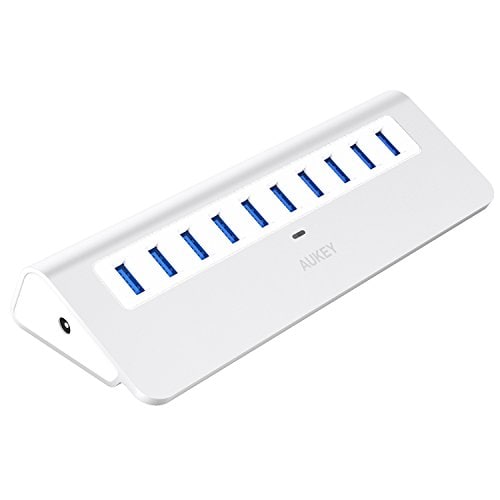
The price of this ten-port Aukey hub, along with a power adapter available at Amazon, is $39.99.
The elegant white design of this Aukey USB data hub is self-effacing. It adds ten vertically oriented USB 3.0 ports to your PC. It enables a data transfer rate of up to 5GBps. This Aukey powered USB 3.0 data hub, along with a power adapter of 36W (12V 3A) AC, ensures safe & steady data transfer for all connected devices. Thus the adapter powers the hub and prevents pulling charge from your laptop.
The hub can be connected to a laptop only through a detachable USB-3.0-A-to-A cable. If your computer only has a USB C port, this cable needs to be swapped out for a USB-3.0-A-to-USB-C.
4. Tecknet HU043 Ethernet and USB 3.0 HUB
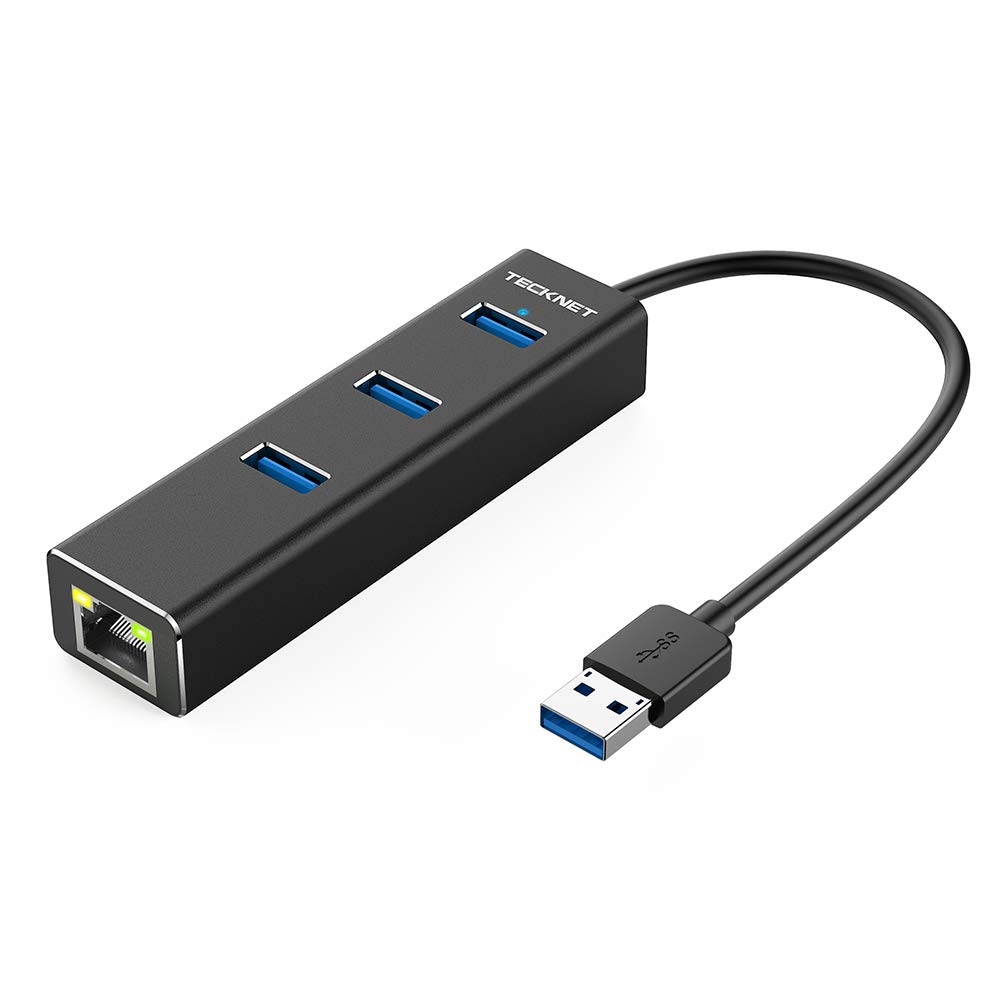
This 3 Tecknet hub, along with ethernet cable available at Amazon, is around $17.90.
This TeckNet hub supports three 5Gbps USB 3.0 ports on top, along with an RJ45 ethernet port on the hub's front face. It provides backward compatibility with USB 2.0 and 1.1 specifications and 10/100 ethernet. In this way, it provides flexibility by making it unnecessary to switch between devices. One gigabit ethernet port provides superfast network speeds of up to 1000Mbps. No matter you're transferring data or charging devices, Its HU043's multiple protections help to avoid any potential harm to your connected devices. It does not require any drivers for USB data transfer.
If you use this tecknet hub, not having an Ethernet port on your laptop can be a problem. Especially if you commonly travel to places that don't precisely know Wi-Fi. Moreover, it's not quite as slim as some other portable options.
5. Sabrent 4-Port USB 3.0 Hub
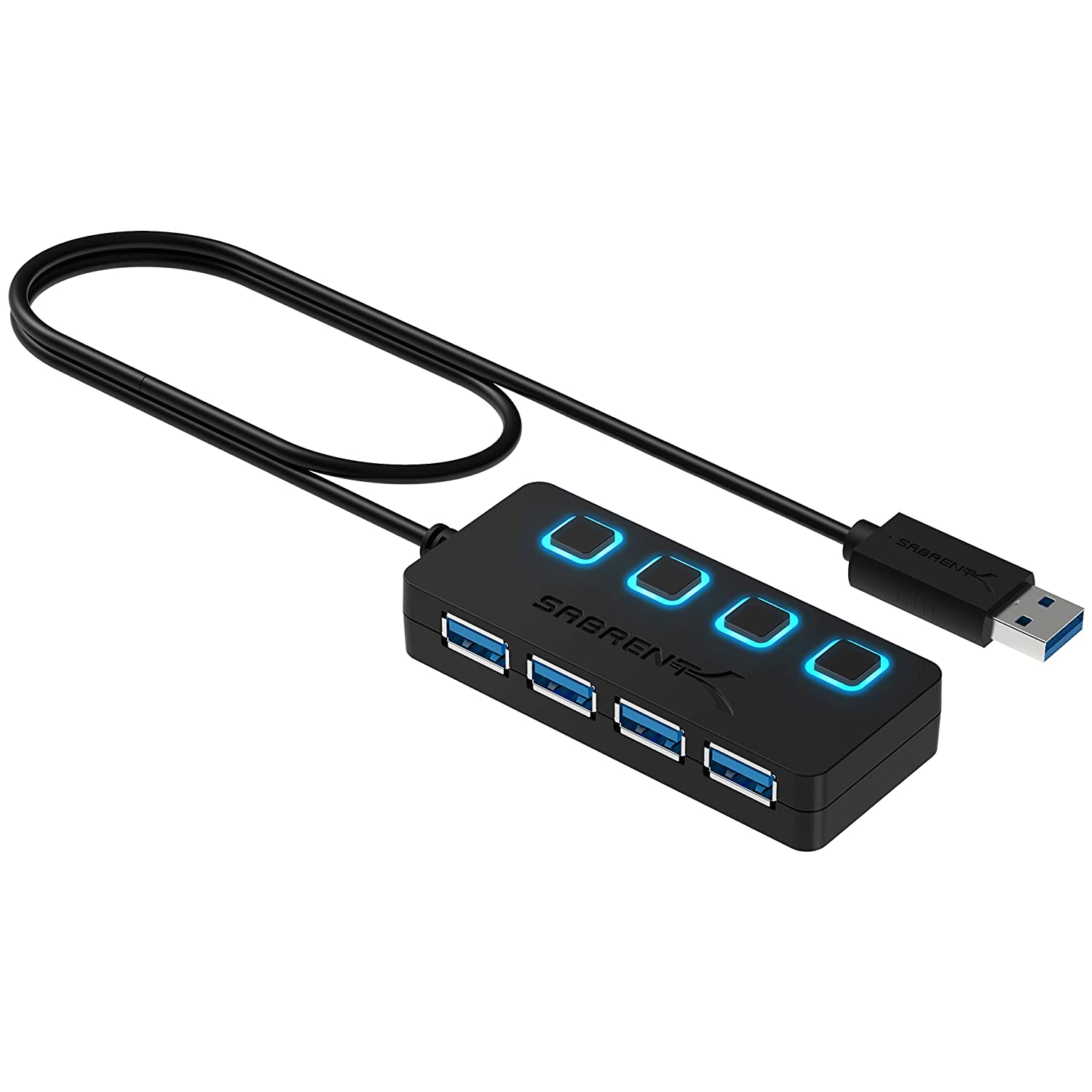
This Sabrent hub, along with individual power switches and LEDs available at Amazon, is around $13.00.
Sabrent perfectly fits your needs if you'd like individual power switches and LED indicators displaying the power status of each port but don't need ten ports. It makes a smaller hub with the same features. The Sabrent USB-A ports deliver data transfer speeds up to 5Gbps (USB 3.0), 480Mbps (USB 2.0), 12Mbps (USB 1.1), and above each port is a press-button switch ringed by blue light. You can easily add four USB 3.0 Ports to any compatible device.
It provides backward compatibility for USB 2.0 and USB 1.1. It consists of an additional power switch for each port, allowing for individual port control.
This Sabrent hub does not enable you to charge your devices but only sync. It is compatible only with Windows 2000/XP/Vista/7/8/8.1/10, Mac OS 9.1 & Higher, and Linux 2.4 or above. Moreover, for a stable connection, the 4-Port USB 3.0 Hub devices must not exceed a combined current of 5 volts 900 mAh.
How to Use the Adapter?
Once you have purchased a USB 3.0 adapter from the above list, you need to understand how to use it with your PC or laptop.
All you have to do is to plug your USB adapter into your PC or Laptop. Your system will take some time to detect the newly installed drivers for it. The drivers for your adapter will be installed automatically. Still, in case if it fails, you can manually install the drivers too. That's it. You have your USB 3.0 adapter up and running.

The Bottom Line
Hopefully, now you are familiar with the benefits of USB 3.0, and you can easily distinguish it from any other USB standards, i.e., USB 2.0 or below. Since not every computer supports or comes with USB 3.0, you need a USB 3.0 adapter for that.
Our list consists of the well-known best USB 2.0 to 3.0 adapters out there. You can now opt for the above-listed adapters for your systems, fulfilling the best of your needs that contain full features and an affordable price.
However, if you are looking for the cheapest and most reliable solution to your problem, the Sabrent 4-Port adapter stands out.
USB Topic
- Recover USB Drive
- Format USB Drive
- Fix/Repair USB Drive
- Know USB Drive









 ChatGPT
ChatGPT
 Perplexity
Perplexity
 Google AI Mode
Google AI Mode
 Grok
Grok
























Theo Lucia
chief Editor